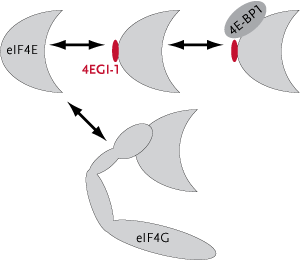A newly identified compound, one that is providing researchers with unique insights into translational regulation of gene expression, may also light the path to a new form of cancer treatment.
In the Jan. 26 Cell, HMS researchers report that 4EGI-1, a small, synthetic molecule identified via a novel high-throughput screen, induces apoptosis in some cancer cells, stops the growth of others, and inhibits cellular expression of oncogenic proteins. The tiny molecule achieves these monumental feats by blocking the union of two proteins whose binding is required to initiate translation of most growth and proliferation-related proteins.
The findings, reported by Gerhard Wagner, the Elkan Blout professor of biological chemistry and molecular pharmacology, and his colleagues, provide the latest proof of principle for an elusive but promising concept: combating disease by blocking normal binding interactions with small molecules.
“There is always some skepticism about whether one can actually inhibit a given protein–protein interaction using just a small molecule,” said research fellow Nathan Moerke, the study’s lead author.
For some proteins, especially those that play a role in cell growth and proliferation, translation is initiated by a group of molecules termed “initiation factors” that gather at the 5’ end of the corresponding mRNA to recruit and join ribosomal subunits. A key step in this process—known as cap-dependent translation—is the interaction of two specific initiation factors that bind to form part of a larger multiprotein complex. The two initiation factors, eIF4 variants E and G, form eIF4F. Small molecules that possess the same sequence that G uses to bind to E regulate the system by binding to E and sequestering the two initiation factors from one another. These endogenous regulators, 4E-BPs, are, in turn, controlled by mTOR, a kinase that phosphorylates them, diminishing their binding affinity.
In recent years, small molecules—long recognized for their ability to shed light on molecular processes—have emerged as an appealing drugdiscovery objective. Researchers around the world have scoured countless chemical libraries for a potential David to match a range of Goliaths, including Alzheimer’s, cancer, and HIV. At the same time, misregulation of cap-dependent translation has been implicated in a range of human diseases, from hypertrophic cardiopathy (an excessive thickening of the heart muscle) to tuberous sclerosis (the growth of benign tumors in the brain, kidneys, and other organs) to malignant tumors such as cancer of the lung and breast. Excessive cellular eIF4F has been shown to play a key role in tumorigenesis, and elevated eIF4E levels are characteristic of several tumor types. At the same time, 4E-BP overexpression has proven an effective means of arresting tumor growth. While several mTOR inhibitors with demonstrated antitumor activity are currently being evaluated as cancer drugs, the possibility of blocking the eIF4E–eIF4G interaction was “an open question,” according to Moerke—until now.
The group screened 16,000 compounds, looking for one that would displace a fluorescein-labeled peptide derived from the G sequence that bound to the E form at the same site. Eventually they turned up 4EGI-1, which displaced eIF4G by binding to a smaller subset of its binding site. The newly found molecule had the added advantage of enhancing 4E-BP1 binding, a surprise given that this molecule is also believed to bind eIF4E via the same motif. It appears that by displacing the G sequence without blocking the entire binding interface of E, 4EGI-1 is able to clear the docking site of the endogenous regulator.

4EGI-1 was shown to induce apoptosis in Jurkat leukemia cells and appears to inhibit proliferation of A549 lung cancer cells. Another bonus: it seems to preferentially downregulate growth, proliferation-related, and anti-apoptotic proteins—all of which are encoded by “weak mRNAs.” The molecule appears to have little effect on “strong mRNAs,” which typically encode proteins required for normal cellular metabolism. This suggests that noncancer cells may be more resistant to 4EGI-1, owing to a lower demand for proteins encoded by weak mRNAs.
Still, the synthetic warrior did not prove potent enough to be considered a viable drug candidate. It is not only this molecule, however, but also the high-throughput assay enabling its discovery that holds promise for a potential cancer therapy. “The next step would be to either design better analogs of this compound and test them in the same experiments or use this assay to screen more libraries for better initial compounds,” Moerke explained.


